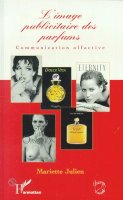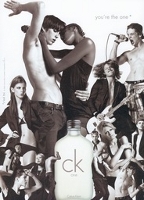 Somewhere in my attic lies a binder with print ads for unisex perfumes. It’s a rather singular collection of images from fashion magazines that I used for my graduate thesis in 1997. I was interested in the way people were portrayed in those ads: the famous cK one and cK Be series, featuring young models shot in black and white, seemed to announce some sort of iconographical revolution in the world of perfumery. I even considered exploring the connection between images and fragrances, but I quickly decided it would only complicate things. Later I found out that someone else had actually taken up that challenge: Mariette Julien’s L’image publicitaire des parfums (1997) is the first study dedicated to the semiotics of perfume ads. It raises a very difficult question indeed: how does one visualize the essence of a perfume in a print ad?
Somewhere in my attic lies a binder with print ads for unisex perfumes. It’s a rather singular collection of images from fashion magazines that I used for my graduate thesis in 1997. I was interested in the way people were portrayed in those ads: the famous cK one and cK Be series, featuring young models shot in black and white, seemed to announce some sort of iconographical revolution in the world of perfumery. I even considered exploring the connection between images and fragrances, but I quickly decided it would only complicate things. Later I found out that someone else had actually taken up that challenge: Mariette Julien’s L’image publicitaire des parfums (1997) is the first study dedicated to the semiotics of perfume ads. It raises a very difficult question indeed: how does one visualize the essence of a perfume in a print ad?
The basic premise of the book is that perfume ads contain symbols and signs that belong to the realm of olfactory communication. When you compare perfumes and their respective ads — the author collected and analyzed 300 advertisements published between 1986 and 1996 — you end up with a whole set of ‘olfactive markers’: visual messages that in one way or another reflect the perfume’s odorant properties. A simple example of an olfactive marker is the blue sea in Davidoff’s Cool Water ads: besides triggering various iconographical associations (like the sense of freedom suggested by the wideness of the sea), it actually conveys the concept of ‘freshness’ that is promoted as a characteristic of the fragrance itself…
 As part of
As part of